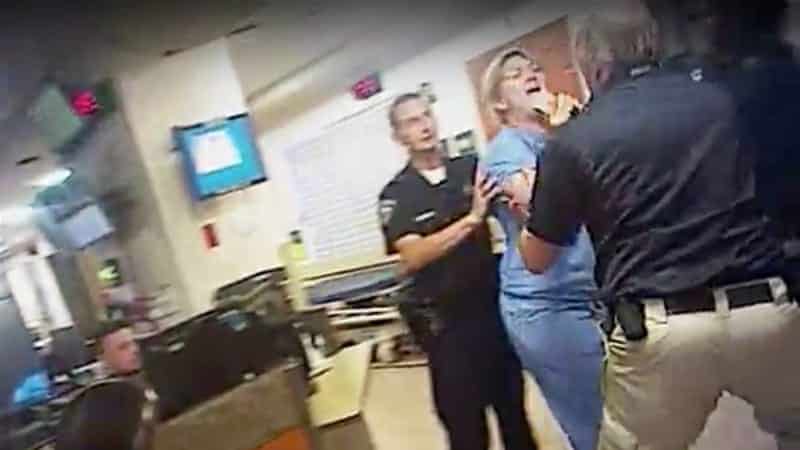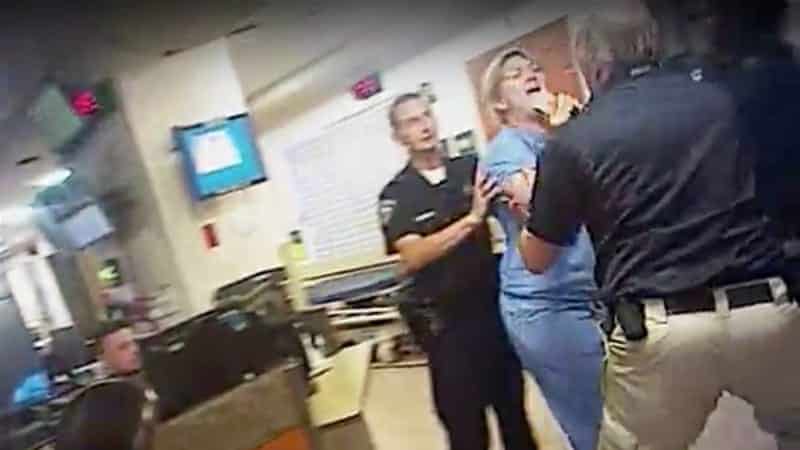
Documentarian Michael Moore, in a Friday post at Twitter, linked to video of Alex Wubbels, a nurse at a Salt Lake City, Utah hospital, being arrested for refusing to comply with a police demand that she draw blood from an unconscious patient at the hospital without first the patient consenting, the patient being arrested, or a warrant being issued. While Moore admirably alerted people to what he termed the “authoritarian police state” in America and provided them with a vivid example of that police state in action, he clouded the issue by wrongly suggesting that the police state is a new creation caused by Donald Trump being president of the United States.
Moore, in his tweet, included a link to video of some of the encounter between Wubbels and police preceded by this comment:
Here’s what it looks like now in Trump’s America. The authoritarian police state he so loves is now everywhere. Please watch this video.
Moore’s sharing of the video and his cautioning regarding an authoritarian police state do a service for liberty. The decades-in-the-making expansion of police invincibility when cops assault or kill people needs to be seen and understood by Americans so it can be rolled back. Overcoming this invincibility, I wrote in an August of 2015 Ron Paul Institute article, can be powered by “widespread public examination” of police misconduct. Widespread sharing and discussion of the Wubbels video, for example, can help counter what I called in the article the “standard cop-protecting narrative” in which “police leadership, as well as police union and government officials, immediately line up expressing great deference for the cop’s action, while painting the injured or killed individual in the worst possible light.”
However, the suggestion that the police state came into being in America in the roughly seven months since Donald Trump became president is a disservice to liberty. The suggestion distorts the historical development of the police state in America decade after decade irrespective of who was president and what party affiliations the presidents had. Moore, who supported Democratic Party Presidential Nominee Hillary Clinton in the 2016 presidential election, suggests in his tweet that, if we just have someone else in the White House, the police state and abusive police actions like the ones in the video would go away. This suggestion belies recent history.
Take a look at the eight years of President Barack Obama’s presidency. Police then were engaging in plenty of actions as threatening to liberty as those that occurred with Wubbels. Consider, for example, the abuse suffered by Sandra Bland in the summer of 2015 after a cop pulled over her car in Texas for an alleged lane change without signaling and the arrest of South Carolina high school student Niya Kenny in the fall of 2015 after she filmed and complained about a cop’s rough treatment and arrest of a fellow student.
Bland and Kenny are two among many victims of the police state in the Obama years. To see more examples, look through some of Rutherford Institute President John W. Whitehead’s editorials, including his August of 2016 editorial “Killer Instincts: When Police Become Judge, Jury and Executioner” in which Whitehead discusses some actions he thinks could help end the police state in America.
Further, consider the disturbing Obama era statistic of about three people a day being killed by police. As I noted in my December of 2015 article “Is There a War on Police or a War on Us?” some of these killings were justified to “end an immediate threat to kill or seriously injure others,” but “the lives lost include also individuals who posed no such threat.” An approach to policing that emphasizes an “us versus them” attitude, an overwhelming focus on “officer safety,” brisk commands instead of discussion, and a bias toward escalating violence significantly contributes to unnecessarily increasing the number of people roughed up and even killed by police.
The huge increase in the use of SWAT teams over the last few decades provides an illustration of the change in approach to policing. In very informative testimony regarding police in America before the US Senate Homeland Security and Governmental Affairs Committee in September of 2014, Eastern Kentucky University Professor Peter B. Kraska related that there “had been more than a 1,300 percent increase in the total number of police paramilitary deployments, or call-outs, between 1980 and the year 2000” and the increase continued since, with deployments of SWAT teams in America now numbering in the tens of thousands each year. Also, Kraska notes, instead of SWAT teams being deployed to deal with “particularly dangerous events already in progress, such as hostage, sniper, or terrorist situations,” the vast majority of SWAT team deployments are now for “random patrol work, and no-knock and quick-knock dynamic entries into private residences, searching for contraband (drugs, guns, and money).”
The fact that the police state predates Trump’s presidency does not mean, however, that we should not be concerned about Trump helping continue and even accelerate its ascent. Indeed, during his presidential campaign, Trump promoted “law and order” policies that would expand police power and pose increased danger for liberty, such as encouraging the use of New York City-style stop-and-frisk to deal with “gun violence” and reversing some limits President Barack Obama placed in 2015 on the transfer of military weapons and equipment to state and local police. Last week, Trump did roll back the military weapons and equipment limits, though that change by itself is less significant than many people may believe given that transfers generally had grown enormously during the Obama administration.
Also concerning is Trump’s declaration, at a February speech to the Major Cities Chiefs police organization soon after becoming president, that he desires to pursue a “ruthless” war on drugs. The war on drugs, after all, has been ruthless for quite some time and is one of the biggest excuses for ditching protections of liberty and building the American police state. Yet, Trump suggests that he thinks the drug war is not yet ruthless and that he desires to make it so.
Still, while it is justified to worry that Trump may help increase the menace of the American police state more than have some previous presidents or than would alternatives such as his 2016 Democratic opponent, it is wrong to place the blame on Trump for the existence of the police state. And, unless there is enough pressure from the people to restrain it, we should expect the police state to stick around and even grow irrespective of who is living in the White House.
Dismantling the American police state will require a combined effort of people across the political spectrum. There are many concentrated interests, from police unions to weapons manufacturers, who have much to gain from the existence and expansion of the police state. They can and have worked well with presidents, governors, legislators, mayors, and city council members whether those politicians have a Democratic or Republican affiliation. And they are thrilled to know that Americans are placing faith in in the idea that just changing who is president will end the police state problem.
Michael Moore’s tweet will hopefully help many people recognize the extent of danger the police state poses. Should some of these people undertake some additional research, they can uncover that the problem, with its deep roots and long history, will not just disappear if Trump is no longer president. The police state can disappear, but likely only after a challenge pursued by a coalition of people the breadth of which extends across and beyond political party and “left/right” affiliations.

